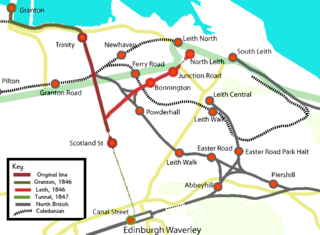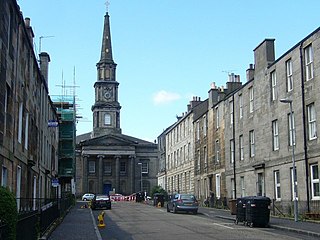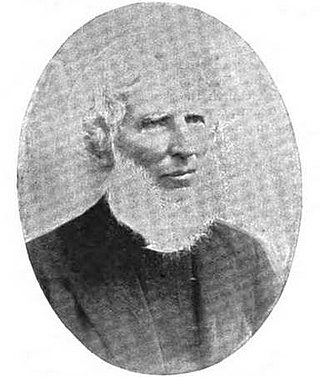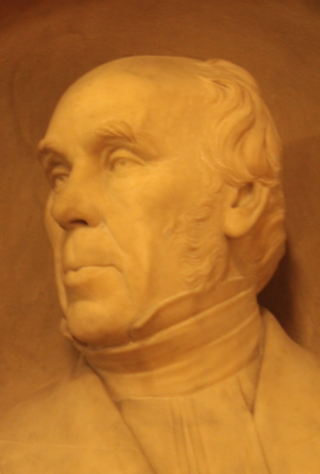
Leith is a port area in the north of Edinburgh, Scotland, founded at the mouth of the Water of Leith.
Sighthill is a suburb in the west of Edinburgh, Scotland. The area is bordered by Broomhouse and Parkhead to the east, South Gyle to the north, the industrial suburb of Bankhead and the Calders neighbourhood to the west, and Wester Hailes to the south. It is sometimes included in the Wester Hailes area, while the Calders, Bankhead and Parkhead are sometimes considered parts of Sighthill. Administratively it has formed a core part of the City of Edinburgh Council's Sighthill/Gorgie ward since 2007.

Broughton is an ancient feudal barony, today an area of Edinburgh, Scotland.

Bonnington is a district of Edinburgh, the capital of Scotland. The area centres upon an original village which grew up around a ford on the Water of Leith, on the old boundary between Edinburgh and the port of Leith. Before the creation of Leith Walk, the road via the villages of Broughton and Bonnington, or Wester Road as it appears on some old maps, was one of two roads formerly connecting Edinburgh to Leith; the other being Easter Road. The district lies between the districts of Pilrig and Newhaven.

The colony houses of Edinburgh were built between 1850 and 1910 as homes for artisans and skilled working-class families by philanthropic model dwellings companies. The first development was the Pilrig Model Buildings, near Leith Walk. Later developments across the city were built by the Edinburgh Cooperative Building Company Limited, founded in 1861. The founders of this company were influenced by the Reverend Dr. James Begg and the Reverend Dr. Thomas Chalmers, ministers of the Free Church of Scotland, who campaigned to improve the housing conditions of the poor.

Great Junction Street is a street in Leith, on the northern outskirts of Edinburgh, Scotland. It runs southeast to northwest following approximately the southwestmost line of the old town walls around Leith.

Major Thomas Weir was a Scottish soldier and presumed occultist, executed for bestiality, incest and adultery.

Leith Walk is one of the longest streets in Edinburgh, Scotland, and is the main road connecting the east end of the city centre to Leith.
Edinburgh Corporation Tramways formerly served the City of Edinburgh, Scotland. The city used four-wheeled double-decked trams painted dark red (madder) and white – a livery still used by Lothian Buses and the modern light rail Edinburgh Trams.

The Edinburgh, Leith and Newhaven Railway was a railway company formed in 1836 to connect the city of Edinburgh with the harbours on the Firth of Forth. When the line connected to Granton, the company name was changed to the Edinburgh, Leith and Granton Railway. It opened part of its route in 1846, but reaching the centre of Edinburgh involved the difficult construction of a long tunnel; this was opened in 1847. It was on a steep incline and was worked by rope haulage.

South Leith Parish Church, originally the Kirk of Our Lady, St Mary, is a congregation of the Church of Scotland. It is the principal church and congregation in Leith, in Edinburgh. Its kirkyard is the burial place for John Home and John Pew, the man from whom the author Robert Louis Stevenson reputedly derived the character of Blind Pew in the novel Treasure Island. The church has been repaired, used as an ammunition store and reconstructed but still retains the basic layout of the nave of the old church.

Trams operated in Edinburgh from 1871 to 1956, and resumed in 2014. The first systems were horse-drawn, while cable-haulage appeared in the city in 1888. Electric trams first ran on systems in neighbouring Musselburgh (1904) and Leith (1905), meeting the Edinburgh cable-trams at Joppa and Pilrig respectively. Electrification meant cable trams last ran in 1923, with through running now possible to Leith and as far east as Port Seton. The various systems were operated by different private and municipal entities over the years; the Edinburgh and Leith systems had been merged under Edinburgh Corporation by 1920, but it wasn't until 1928, after the partial closure of Musselburgh line, that all trams operating in Edinburgh were in the sole control of the corporation. The last electric trams ran in 1956, but electric trams returned in 2014 with the opening of Edinburgh Trams. Many of the trams from the horse/cable/first electric era were built in Shrubhill Works. Two trams have been preserved, a horse tram and an electric tram, built by Shrubhill in 1885 and 1948 respectively. A 1903 Dick Kerr cable-tram has also been purchased for preservation. Remnants of the cable-tram system can be seen in Waterloo Place and Henderson Row, and of the Musselburgh line at Morrison's Haven.

North Leith Parish Church is a congregation of the Church of Scotland, within the Presbytery of Edinburgh. It serves part of Leith, formerly an independent burgh and since 1920 a part of the city of Edinburgh, Scotland.

James Balfour of Pilrig JP was a Scottish advocate and philosopher.

Rosebank Cemetery is a 19th-century cemetery in Edinburgh. It is located at the junction of Pilrig Street and Broughton Road in the Pilrig area, close to the historical boundary of Leith. The cemetery is protected as a category C listed building.

James Calder Macphail was a Scottish Free Church minister and Gaelic tutor. He is best remembered as a pioneer photographer and one of the first to photograph the Holy Land.
Lewis Balfour (1777–1860) was a Scottish Church of Scotland minister and grandfather to the author Robert Louis Stevenson.

Greenside is a district and parish in Edinburgh between Calton Hill and the New Town.

John Paul DD (1795–1873) was a minister of the Church of Scotland who served as Moderator of the General Assembly in 1847. A major figure in Edinburgh society, he was linked to both the Balfours of Leith and the Stevenson family of engineers.






















